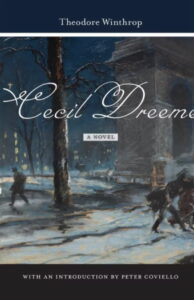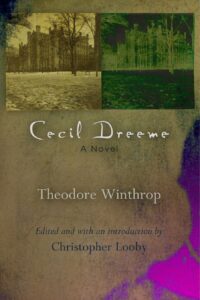Those who’ve had the pleasure of reading Coviello on the errant ways of nineteenth century queer passions or Looby on the essentially literary nature of sexuality won’t be surprised that the two critics have great fun with Cecil Dreeme. Looby’s introduction first traces the novel’s long reception history, including the 1875 teenage journal entry of future queer novelist Henry Blake Fuller; an 1887 review by Julian Hawthorne, who bemoans the novel as “morbid and unwholesome” (while also, tellingly, comparing it to his father’s Blithedale Romance); and an explicitly phobic 2011 New York Times Opinionator column that willfully misreads the novel’s ending as a celebration of heterosexuality’s restoration. This incredible reception history indexes how modern sexual categorizations and their accompanying phobias became increasingly salient over time, and reveals the novel’s suspension between a world “in which same-sex passion was uncontroversial and celebrated and an emerging historical deployment that would soon stigmatize same-sex love as morbid, unwholesome, indecent, and perverse” (xxi). Its unsettled and in-between historical position allows the novel to celebrate socially sanctioned queer desire while simultaneously flirting with the sparkle of excitement that accompanies all things illicit. As Coviello argues, while the novel may predate the full cohesion of same-sex desires into identities, “this did not mean they were not full of titillation, or menace, or—in those wonderful, rarer cases—possibilities for pleasures too great and enticing to be easily forsworn” (xvi). Byng’s queer desires accrue such titillation, Coviello notes, primarily through the figure of Densdeth, the unrelentingly evil yet oh-so-beddable object of Byng’s erotic obsession. As a Gothic archetype, Densdeth lends even sanctioned queer desire the rousing edge of danger and prohibition.
For the most part, Coviello and Looby limit their analysis to the history of sexuality. Yet Densdeth’s gothic plotline positions the novel just as much within a history of race and white supremacy. The gothic, as Richard Wright, Toni Morrison, and Ralph Ellison have all reminded us, accumulates sinister energy through the haunting presence of racial others, and Cecil Dreeme represents both its objects of improper, dangerous desire, Densdeth and Emma Denman, in explicitly racial terms. It describes Densdeth as “Hebrewish”; notes the “resemblance” between him and his servant, “an Afreet creature … black, ugly, and brutal as the real Mumbo Jumbo,” the one a “misbegotten repetition of the other”; and contrasts the appearance of its most benevolent character’s “Saxon coloring of hair and complexion” with “Densdeth’s Oriental hues”(chs. 1 and 5). Likewise, the novel echoes its description of Cecil Dreeme’s gender (“not easy to classify”) when it turns to his/her sister’s race (her “coloring did not classify her”; her “hair was in the indefinite shades”; “[o]ne would not expect from her the steadiness of the fair temperaments, nor the ardor of their warmer counterparts in hue”) (chs. 12 and 16). That we eventually discover these two ambiguously nonwhite characters have been lovers only serves to strengthen the novel’s sexual color line, which is to say, its racial distribution of desire into licit and illicit categories.
Cecil Dreeme thereby joins another nineteenth-century queer novel, Fredric Loring’s Two College Friends (1871), as an early instance of what Jasbir Puar has called homonationalism, which, in both novels, transpires as whiteness lends social sanction to queer desire and gender indeterminacy. In Cecil Dreeme, homonationalism operates through a neat structure in which the illicit and transgressive nature of Byng’s interracial queer desires serve to contrast and normalize his intraracial queer desire for Dreeme, while also haunting the proper love with a faint though entirely wholesome aura of unacceptability. While at the beginning of the novel Robert Byng begs off “Young Americanism,” asking for opportunity to mature “before you expect a man’s work of me,” we’re meant, by the novel’s end, to see his near liberation from desire for either Densdeth or Emma Denman as evidence of having accomplished just that (ch. 1). This novel is, in no small sense, the coming of age of the white queer as Young American.
And yet, as I imagine both Looby and Coviello insisting, let’s not be so neat about it. For, as Looby suggestively argues, “the two love plots (the romantic and the sinister)”— or, I would add, the intra- and the interracial—“meet and gaze at one another—we might almost say cruise each other,” or, as Coviello, with equal suggestiveness, puts it, Byng suffers Densdeth’s inevitable “demise with an altogether post-coital diminishment of spirit” (xxii, xix). Let me conclude, then, by suggesting a complicating layer of illicitness in Byng’s desire for Densdeth: it’s not merely that he desires sex with a nonwhite man; he more specifically desires to bottom for that nonwhite man. The evidence for this is so ubiquitous it almost becomes, for the reader, a running joke, just a few instances of which include Byng’s desire for Densdeth to “dominate” or “pervert” him and Byng’s anally inflected observation that Densdeth keeps touching his “raw spots” (ch. 5). Byng’s bottoming desires throw new light on his observation that attachment to Densdeth would amount to “becoming the hateful foe of my race” (ch. 22). Even as his desire turns on supremacist fantasies of nonwhite masculine virility, it simultaneously betrays Byng’s ambivalence vis-à-vis the color line. He seeks normalization through the displacement of racialized perversity, and yet, simultaneously, experiences an overwhelming urge to be made permeable and throw off the self-enclosed autonomy of white manhood. Ultimately, Cecil Dreeme’s greatest value might be here in this inventory of the contradictory racial impulses structuring white queer desire pulled, on the one hand, toward homonationalism, and, on the other, toward the pleasures of self-annihilation.
I hope it’s clear that I’m just scratching the surface. Cecil Dreeme is an incredibly rich novel that deserves to be taught, read, and studied extensively. Moreover, its two new editions point to exciting developments in queer literary studies, hinting at the ways editorial and critical work are building on and complicating each other. Indeed, the University of Pennsylvania edition is now part of an ongoing reprint series, edited by Looby, which also includes “The Man Who Thought Himself a Woman” and Other Queer Nineteenth-Century Short Stories. All of which means we’re in for a new wave of work exploring not only the messy and uncategorizable aspects of nineteenth-century sexuality and gender, but also the intersection of that messiness with concurrent histories of race, citizenship, religion, and other axes of being.
This article originally appeared in issue 17.2 (Winter, 2017).
Travis M. Foster is an assistant professor of English at Villanova University, where he is completing a manuscript titled After Emancipation: Genres of the New Racial Ordinary.




















